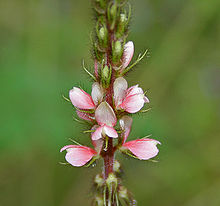
Indigo is a term used for a number of hues in the region of blue. The word comes from the ancient dye of the same name. The term "indigo" can refer to the color of the dye, various colors of fabric dyed with indigo dye, a spectral color, one of the seven colors of the rainbow, or a region on the color wheel, and can include various shades of blue, ultramarine, and green-blue. Since the web era, the term has also been used for various purple and violet hues identified as "indigo", based on use of the term "indigo" in HTML web page specifications.

Indigo dye is an organic compound with a distinctive blue color. Indigo is a natural dye extracted from the leaves of some plants of the Indigofera genus, in particular Indigofera tinctoria. Dye-bearing Indigofera plants were commonly grown and used throughout the world, particularly in Asia, with the production of indigo dyestuff economically important due to the historical rarity of other blue dyestuffs.
Indigo is a color between blue and violet.

Indigofera is a large genus of over 750 species of flowering plants belonging to the pea family Fabaceae. They are widely distributed throughout the tropical and subtropical regions of the world.

Indigofera tinctoria, also called true indigo, is a species of plant from the bean family that was one of the original sources of indigo dye.

Sugathakumari was an Indian poet and activist, who was at the forefront of environmental and feminist movements in Kerala, India.
(Orachrysops ariadne), the Karkloof blue, is a species of butterfly in the family Lycaenidae.

Delhi Capitals are a professional franchise cricket team based in Delhi that plays in the Indian Premier League (IPL). The franchise is jointly owned by the GMR Group and the JSW Sports. The team's home ground is Arun Jaitley Stadium, located in New Delhi. The team is captained by Rishabh Pant and coached by Ricky Ponting. The Capitals appeared in their first IPL final in 2020 against Mumbai Indians.

Indigofera australis, the Australian indigo or Austral indigo, is an attractive species of leguminous shrub in the genus Indigofera. The genus name Indigofera is Neo-Latin for "bearing Indigo". The specific epithet australis, from the Latin, means not “Australian” but "southern", referring to the geographical distribution of the species.

Pune Junction railway station is the main railway junction of the city of Pune, India. It is one of the major railway junctions in Maharashtra. Pune Junction consists of 6 platforms. It also has a suburban train network.
Pendhā was an intoxicating beverage, originating from the Indian subcontinent, made by the Pindari community of mercenaries in central India in the 18th and 19th centuries, and possibly the etymological origin or the group's name. The drink was said to have been made by fermenting sorghum (jowār), or possible Indigofera linifolia.

Indigofera heterantha, commonly known as Himalayan indigo, is a species of flowering plant in the legume family Fabaceae. It is native to the northwestern Himalayas of Tibet, in Asia.

The Mumbai–Chennai line, earlier known as Bombay–Madras line, is a railway line connecting Chennai and Mumbai cutting across southern part of the Deccan Plateau. It covers a distance of 1,281 kilometres (796 mi) across Maharashtra, Karnataka, Telangana, Andhra Pradesh and Tamil Nadu. The Mumbai–Chennai line is a part of Diamond Quadrilateral.

Indigofera linnaei, known as Birdsville indigo and nine-leaved indigo, is a species of leguminous shrub in the genus Indigofera. The genus name, Indigofera, is derived from Latin and means bearing/containing indigo, while linnaei derives from Linnaeus.

Indigofera cordifolia, the heart-leaf indigo, is a species of flowering plant in the family Fabaceae. It is found from the Cape Verde Islands, across the Sahel to Oman, the Indian Subcontinent, Guangdong in China, and some of the islands of Indonesia, and it has been introduced to the Northern Territory of Australia. A glycophyte adapted to sandy soils, it is considered a weed in some situations, but can also improve crop yields due to its nitrogen-fixing ability.

Indigofera cassioides, the cassia indigo, is a species of flowering plant in the family Fabaceae. It is native to the Indian Subcontinent, Southeast Asia, southeast and south-central China, and Taiwan, and has been introduced to Sri Lanka and Kenya. Local artisans use its leaves to produce a blue dye.
Indigofera arrecta, variously called the Bengal, Java, or Natal indigo, is a species of flowering plant in the family Fabaceae. It is native to Sub‑Saharan Africa, the Arabian Peninsula, and Madagascar, and has been introduced to the Indian Subcontinent, Southeast Asia, some of the islands of Indonesia, the Philippines, and Queensland in Australia.
Indigofera galegoides is a species of flowering plant in the family Fabaceae, native to India, South East Asia, Malesia, and southern China. It is a shrub usually 2 m (6 ft) high and indigo dye may be extracted from it by the same harvesting and processing methods as Indigofera tinctoria. It grows in open places and valleys.











